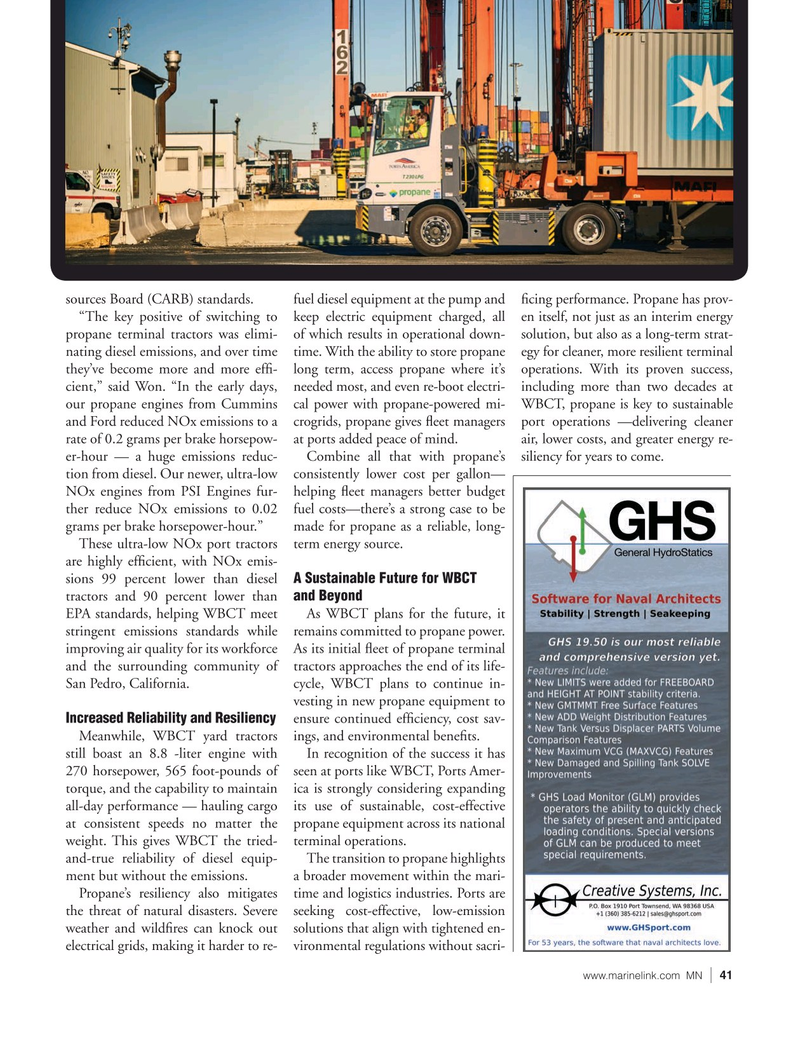
Page 41: of Marine News Magazine (May 2025)
Read this page in Pdf, Flash or Html5 edition of May 2025 Marine News Magazine
sources Board (CARB) standards. fuel diesel equipment at the pump and ? cing performance. Propane has prov- “The key positive of switching to keep electric equipment charged, all en itself, not just as an interim energy propane terminal tractors was elimi- of which results in operational down- solution, but also as a long-term strat- nating diesel emissions, and over time time. With the ability to store propane egy for cleaner, more resilient terminal they’ve become more and more ef? - long term, access propane where it’s operations. With its proven success, cient,” said Won. “In the early days, needed most, and even re-boot electri- including more than two decades at our propane engines from Cummins cal power with propane-powered mi- WBCT, propane is key to sustainable and Ford reduced NOx emissions to a crogrids, propane gives ? eet managers port operations —delivering cleaner rate of 0.2 grams per brake horsepow- at ports added peace of mind. air, lower costs, and greater energy re- er-hour –– a huge emissions reduc- Combine all that with propane’s siliency for years to come.
tion from diesel. Our newer, ultra-low consistently lower cost per gallon—
NOx engines from PSI Engines fur- helping ? eet managers better budget ther reduce NOx emissions to 0.02 fuel costs—there’s a strong case to be grams per brake horsepower-hour.” made for propane as a reliable, long-
These ultra-low NOx port tractors term energy source.
are highly ef? cient, with NOx emis- sions 99 percent lower than diesel A Sustainable Future for WBCT tractors and 90 percent lower than and Beyond
EPA standards, helping WBCT meet As WBCT plans for the future, it stringent emissions standards while remains committed to propane power. improving air quality for its workforce As its initial ? eet of propane terminal and the surrounding community of tractors approaches the end of its life-
San Pedro, California. cycle, WBCT plans to continue in- vesting in new propane equipment to
Increased Reliability and Resiliency ensure continued ef? ciency, cost sav-
Meanwhile, WBCT yard tractors ings, and environmental bene? ts.
still boast an 8.8 -liter engine with In recognition of the success it has 270 horsepower, 565 foot-pounds of seen at ports like WBCT, Ports Amer- torque, and the capability to maintain ica is strongly considering expanding all-day performance –– hauling cargo its use of sustainable, cost-effective at consistent speeds no matter the propane equipment across its national weight. This gives WBCT the tried- terminal operations. and-true reliability of diesel equip- The transition to propane highlights ment but without the emissions. a broader movement within the mari-
Propane’s resiliency also mitigates time and logistics industries. Ports are the threat of natural disasters. Severe seeking cost-effective, low-emission weather and wild? res can knock out solutions that align with tightened en- electrical grids, making it harder to re- vironmental regulations without sacri- www.marinelink.com MN 41|

 40
40

 42
42
